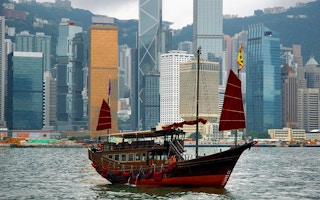This week, Asia’s top two cities Singapore and Hong Kong unveiled Budgets whose measures signal a growing recognition by their governments on the need to tackle rising inequality and build inclusive societies.
To continue reading, subscribe to Eco‑Business.
There's something for everyone. We offer a range of subscription plans.
- Access our stories and receive our Insights Weekly newsletter with the free EB Member plan.
- Unlock unlimited access to our content and archive with EB Circle.
- Publish your content with EB Premium.
While there are similarities in their approach – unsurprising given how they both face common urban challenges such as an ageing population and rising cost of living – their Budgets also reflect different priorities.
Here are my takeaways:
1. Building inclusive societies
Both Budgets this year have devoted significant resources and measures to lift the lower- and middle-income groups.
In Singapore, highlights included support for the middle-class in the form of personal income tax rebates, help with childcare and education costs; increasing social welfare via a Sliver Support Scheme which will give quarterly cash payouts to the poorest among the elderly; and enhancements to the country’s pension scheme. This comes as Singapore celebrates its Jubilee birthday this year, with many political observers expecting a general election that’s due to be called by January 2017.
In Hong Kong, there were tax breaks, increased allowances for care for the elderly and children, and rental waivers for the lower-income.
In many ways, these moves to strengthen social safety nets are a response to the widening income gap that has splintered both societies to varying degrees. Rising inequality was a high profile issue in Singapore’s last general election in 2011 and has dominated the national discourse in the years since, while in Hong Kong the widening wealth gap and unaffordable housing fuelled the pro-democracy Umbrella Revolution that saw the city come to a standstill last year.
2. Singapore’s Budget is more progressive
While both governments have signalled intents to deal with inequality, Singapore’s approach is far more progressive and aggressive.
This week, it announced the first increase in the top income tax bracket in a decade, raising taxes on the richest five per cent of its citizens, marking a bold move by the government towards redistributive policies that directly tax the rich to fund government spending on welfare programmes.
Hong Kong has kept its tax rate at a flat 17 per cent for those with income above HK$120,000 (S$21,000), reflecting its commitment to a low-tax, free market style of government. But its measures, mostly one-off sweeteners, have been criticised by analysts as being short-term and not tackling the root causes of its social problems.
EY managing partner for tax for Hong Kong and Macau, Tracy Ho, noted in a report that over the past six or seven years, the financial secretary has given away HK$272 billion as one-off sweeteners. “If that much money was spent elsewhere it could actually benefit Hong Kong more in the long term.”
3. Boost for business
Both cities demonstrated that businesses still rank high on the priority list as they seek to address their respective economic challenges. Singapore’s Budget featured schemes to help employers adjust to a tight labour market by supplementing wage increases for workers, extending corporate income tax rebates.
It announced grants for companies to support innovation and expansion overseas even while it rolled out programmes to upgrade the skills of workers.
Hong Kong devoted a fair chunk of change to help businesses affected by the recent Occupy movement, announced increased investments into its tourism industry, and incentives for the financial services industry. Last year’s democracy protests saw hundreds of thousands of people blocking major roads for 79 days to protest Beijing’s curbs on the planned inaugural vote in 2017 for the city’s top leader.
4. Singapore: An eye on carbon emissions
Beyond the social aspects, there were elements in Singapore’s Budget that reflected a larger effort by the government to realise its vision for the country to be a sustainable, liveable city.
The country’s $1.5 billion ‘Sustainable Singapore Blueprint’ unveiled last November outlined a vision of Singapore as a ‘car-lite’ and zero waste nation of eco-towns that also is a leading green economy.
In this vein, the Budget featured improvements to the Carbon Emissions-based Vehicle Scheme which encourages a shift to greener cars by providing financial rebates for green car owners while penalising those who own more pollutive models.
There was also a separate scheme to encourage the replacement of older commercial vehicles with greener ones that meet higher emission standards.
Taking advantage of historically low oil prices, the government also moved to increased petrol duty by a hefty 15 to 20 cents with immediate effect to “encourage lower car usage and reduce carbon emission”.
5. Clean air for Hong Kong
With air pollution worsening in the Chinese city and the region, Hong Kong is introducing legislation this year to require all ocean vehicles at berth in Hong Kong to use low sulphur diesel.
The government is also phasing out earlier, more pollutive diesel commercial vehicles by 2019, and is extending its Cleaner Production Partnership Programme which provides funding for Hong Kong-owned factories in the Pearl River Delta region to adopt cleaner production technologies and practices.
It also announced a new study on the leisure and recreational value of the coastal areas of Victoria Harbour as well as a new desalination plant.
Overall, Singapore’s Budget is a more “left leaning” one than Hong Kong’s – with both cities taking varying steps to strengthen social safety nets and build more equitable societies.
This is important, especially given the growing importance of inclusiveness and collective responsibility on the global agenda. In the proposed Sustainable Developments Goals (SDGs), due to be finalised at a United Nations summit in September, the word “inclusive” appears six times, reflecting a global development agenda that puts social equity at the centre.
It is encouraging that both Asian cities seem to be making efforts on this front.











